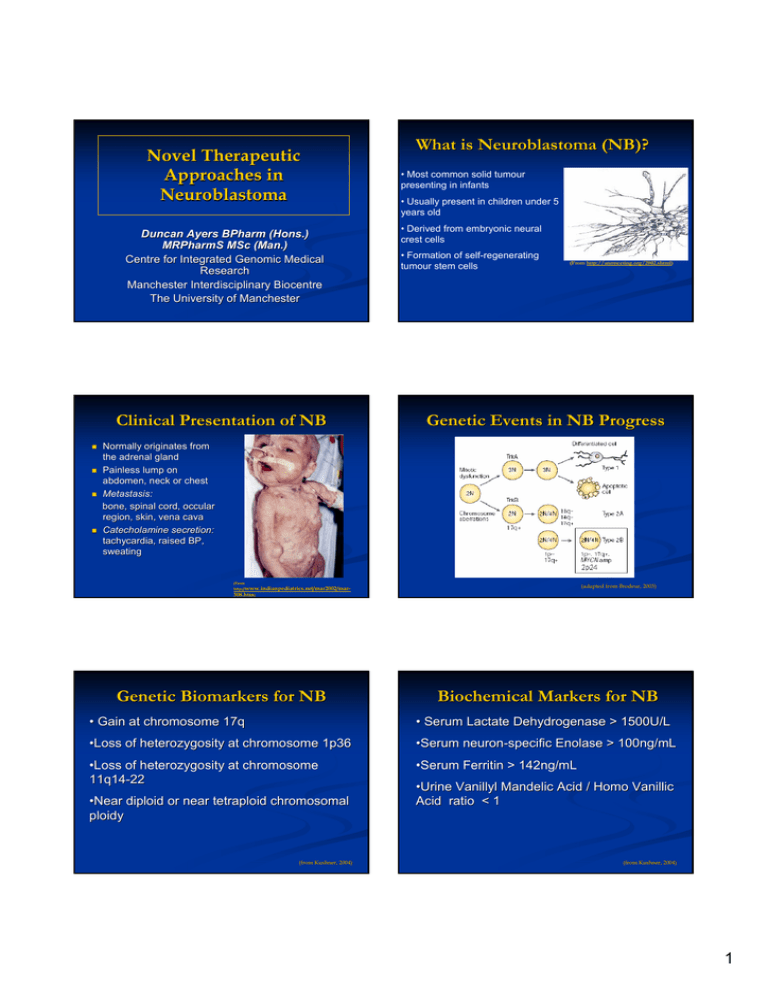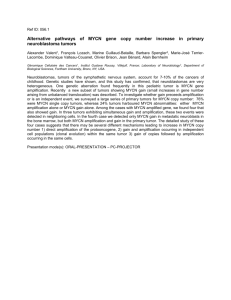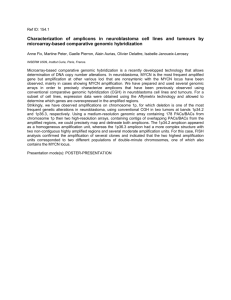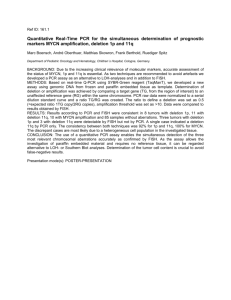What is Neuroblastoma (NB)? Novel Therapeutic Approaches in Neuroblastoma
advertisement

Novel Therapeutic Approaches in Neuroblastoma Duncan Ayers BPharm (Hons.) MRPharmS MSc (Man.) Centre for Integrated Genomic Medical Research Manchester Interdisciplinary Biocentre The University of Manchester Clinical Presentation of NB What is Neuroblastoma (NB)? • Most common solid tumour presenting in infants • Usually present in children under 5 years old • Derived from embryonic neural crest cells • Formation of self-regenerating tumour stem cells (From http://anrmeeting.org/2002.shtml) Genetic Events in NB Progress Normally originates from the adrenal gland Painless lump on abdomen, neck or chest Metastasis: bone, spinal cord, occular region, skin, vena cava Catecholamine secretion: tachycardia, raised BP, sweating (From (adapted from Brodeur, Brodeur, 2003) http://www.indianpediatrics.net/mar2002/marwww.indianpediatrics.net/mar2002/mar- 308.htm) Genetic Biomarkers for NB Biochemical Markers for NB • Gain at chromosome 17q • Serum Lactate Dehydrogenase > 1500U/L •Loss of heterozygosity at chromosome 1p36 •Serum neuronneuron-specific Enolase > 100ng/mL •Loss of heterozygosity at chromosome 11q1411q14-22 •Serum Ferritin > 142ng/mL •Near diploid or near tetraploid chromosomal ploidy (from Kushner, 2004) •Urine Vanillyl Mandelic Acid / Homo Vanillic Acid ratio < 1 (from Kushner, 2004) 1 Molecular Biomarkers for NB Other Biomarkers for NB • MYCN oncogene amplification • TrkA & TrkC: TrkC: low or absent expression • Age : increased mortality in children over the age of 12 months •TrkB: TrkB: High expression •Telomerase: Increased activity or high expression • Unfavourable Shimada histopathology on examining NB biopsies •CD44: Low or absent expression (CD44 is involved in cell – cell adhesion propetries) (from Kushner, 2004) Pitfalls of Conventional Chemotherapy NonNon-specific mode of action across most tissue types DoseDose-dependent cumulative adverse effects (eg. Cisplatin) (from Kushner, 2004) Principles of Translational Medicine Molecular biology advances lead to enhanced insight in tumour aetiology and pathogenesis at the molecular level Discovery of novel key molecules & receptors which can be exploited as novel drug targets Such tumourtumour-specific drugs will have lower adverse effects and thus not be dose limited - Dose limitations, thus reduced efficacy Resistance emergence to cytotoxic agents - Multiple cytotoxic agents must be used, with more distress to patient List of Novel Therapies for NB MYCN oncogene inhibition Anti – Telomerase strategies Prevention of tumour angiogenesis Immunotherrapeutic strategies Retinoid therapy Aptamers / RNAi Induction of apoptosis MYCN Inhibition Strategies •http://users.ugent.be/~fspelema/neubla/images http://users.ugent.be/~fspelema/neubla/images •http://www.ncl.ac.uk/nicr/assets/photos http://www.ncl.ac.uk/nicr/assets/photos 2 MYCN Inhibition Strategies MYCN Inhibition Strategies Targeting of MYCN gene expression - gene silencing using RNAi Disruption of MYCNMYCN-MAX protein interactions MYCN (from Ponzielli et al, 2005) MAX NB developmental effects by gene transcription & expression Anti-Telomerase Strategies Anti-Telomerase Strategies ( adapted from Keith et al, 20002) (Adapted from Binz et al, 2005) Anti-Angiogenesis Strategies Immunotherapeutic Strategies (adapted from Ribatti et al, 2002) Increased vascularization in NB tumours, especially when MYCN amplification present Vascular endothelial growth factor (VEGF) inhibition using aptamers a. Normal MYCN expression b. Increased MYCN expression Exploitation of key molecules in inflammatory & immune response (eg. In antiantiangiogenesis) Monoclonal Antibody therapy (eg. AntiAntidiasialoganglioside 2) (adapted from: A. Halin et al, 2002; B. Dickerson et al, 2004; C. Borsi et al, 2003) 3 Retinoid Therapy Aptamer Exploitation Effective in controlling NB proliferation and enhancing differentiation Bind to retinoic acid receptors and allow for control of gene expression in NB cells (adapted from Reynolds et al, 2003) Aptamers are synthetically produced molecules consisting of single stranded DNA or RNA Aptamer applications include various analytical and diagnostic techniques, including their implementation as biosensors, or as antisense sequences for oncogenes •www.univie.ac.at/.../ The Future of AntiAnti-NB Therapy... Induction of Apoptosis (NB 4S Stage) • Understanding the mechanisms inducing apoptosis in NB 4S stage is essential for new anti – NB therapies • Identification and control of InhibitorInhibitor-ofof-Apoptosis Protein (IAP) family (eg.survivin, livin) Involvement of pharmacogenetics approach to drug design Creating antianti-cancer drugs according to their gene expression profile on target cells thus avoiding collateral damage to nonnon-target cells i.e. Switch OFF only the oncogenes whilst not influencing other genes Studying abroad isn’ isn’t boring .... !! 4






